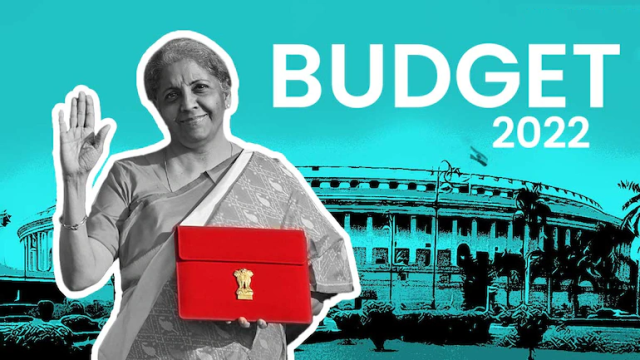*Paromita Das
On Tuesday, Indian Finance Minister Nirmala Sitharaman presented the annual Union Budget for the fiscal year 2022-2023 in Parliament in New Delhi, the nation’s capital, on 1st February 2022.
Sitharaman stated in her introductory remarks that India’s growth is predicted to be 9.2%, the highest among all global economies, and that the country is now well-positioned to face problems such as the coronavirus (COVID-19).
The finance minister also stated that the country is experiencing an Omicron wave, but that the rapid immunization program has substantially aided the situation. “I am optimistic that ‘Sabka Prayaas’ will continue to expand,” she remarked.
The finance minister went on to say that this year’s Union Budget aims to establish the groundwork and provide a framework for the economy over the next 25 years, from India’s 75th to India’s 100th birthday.
The budget was not printed, as it was last year, but it will be available through an app called “Union Budget Mobile App.” Last year, the app was launched to provide Members of Parliament (MPs) and the general public with simple access to Budget papers.
The mobile app provides full access to the 14 Union Budget papers required by the Constitution, including the Budget Speech, Annual Financial Statement (commonly known as Budget), Demand for Grants (DG), Finance Bill, and others.
- Defence R&D opened up to entrepreneurs in India’s Union Budget 2022.
As India’s defences face many problems around the country, Finance Minister Nirmala Sitharaman outlined a strategy to bolster the defence sector during the introduction of the Budget 2022 in Parliament, on 1st February 2022.
Key highlights of the defence sector in Budget 2022:
- Capital for the defence sector will be allocated to local industry at a rate of 68 percent, up from 58 percent last year.
- 25% of the defence R&D budget will be made available to startups, industry, and academics.
- Private companies will be encouraged to work with the DRDO on the design and development of military platforms.
- Promote Aatmanirbharta and lessen reliance on defence equipment imports. Indian Finance Minister Nirmala Sitharaman declared during the presentation of the Budget 2022-2023 that Animation, Visual Effects, Gaming, and Comics (AVGC) have a huge potential for youth employment.
“An AVGC promotion task force will be established with all stakeholders to recommend strategies to achieve this and enhance domestic capacity to serve out markets and global demand,” Sitharam added.
Nirmala Sitharaman, India’s Finance Minister announced the budget for fiscal year 2022-23 on Tuesday, February 1.
The budget for this year intends to enhance growth despite the current pandemic’s interruption.
An AVGC promotion task team would be established to promote animation, gaming, and comics in the Indian Union Budget 2022.
- Revamped women’s and child development initiatives will give benefits, according to Sitharaman.
In the presence of Prime Minister Narendra Modi and other members of Parliament, Indian Finance Minister Nirmala Sitharaman delivered the country’s Budget for the year 2022-2023
During her Budget presentation, Sitharaman stated that the government has redesigned the Ministry of Women and Child Development’s initiatives such as Mission Shakti, Mission Vatsalya, Saksham Anganwadi, and Poshan 2.0 to deliver benefits.
The Finance Minister went on to say that the PM development measures for the North East will be executed for the North Eastern Council, allowing youth and women to engage in livelihood activities. This programme is not intended to replace current federal or state programmes.
- Start-ups will be fostered to facilitate ‘Drone Shakti,’ according to the Indian Union Budget 2022. Nirmala Sitharaman is an Indian politician.
On Tuesday, February 1 in the nation’s capital, New Delhi, Indian Finance Minister Nirmala Sitharaman presented the annual Union Budget for the year 2022-2023 in Parliament.
“Startups will be supported to facilitate Drone Shakti through various applications and for a drone as a service,” Sitharaman stated, introducing a new idea.
“Required skilling courses will be initiated in certain ITIs across all states,” she noted.
The country is fighting the Omicron wave, but the vaccination campaign’s pace has helped. “I am optimistic that ‘Sabka Prayaas’ will continue to grow at a rapid pace,” Sitharaman remarked.
- A national tele mental health initiative will be started in India’s Union Budget 2022.
Nirmala Sitharaman, India’s Finance Minister released the budget for fiscal 2022-23 on Tuesday, aiming to increase growth amid continuous disruption from COVID-19 and growing prices.
The Indian Finance Minister discussed how the virus has damaged people’s mental health and the actions being taken by the government to address this serious side effect of the pandemic while introducing the budget.
According to her, “People of all ages have been affected by the pandemic, which has exacerbated mental health issues. A National Tele Mental Health programme will be created to improve access to high-quality mental health counselling and treatment services.”
She went on to say that the programme will be run by 23 nodal centres for tele medical mental health, with NIMHANS serving as the nodal centre. Technical assistance will be provided by the International Institute of Information Technology (IIIT) in Bengaluru, she added.
As a result of the worldwide humanitarian crisis, mental health issues have been documented all across the world.
Restrictions on social interaction, lockdowns, economic hardship, and school and workplace closures have all contributed to a sharp surge in sadness and anxiety.
Major depression and anxiety disorders are on the rise, according to a study published in The Lancet medical magazine in October. This is especially true among women and youth.
According to the survey, the prevalence of such illnesses has increased by roughly 35% in India.
Researchers anticipate that the pandemic will cause an additional 76.2 million cases of anxiety disorders and 53.2 million cases of severe depression by 2020. As a result, the disorders increased by 25.6 and 27.6 percent, respectively.


Comments are closed, but trackbacks and pingbacks are open.